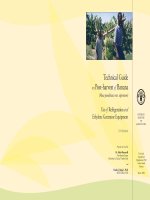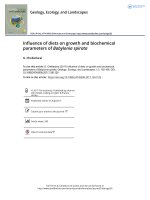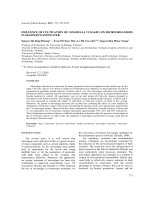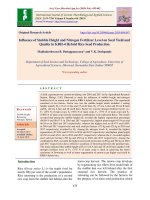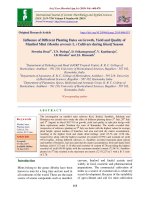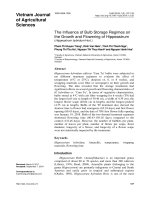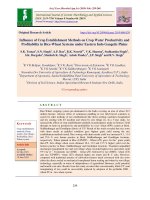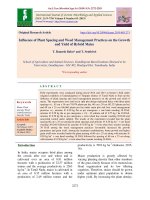Studies on influence of post shooting sprays of nitrogen and potassium on quality attributes of banana cv. grand naine
Bạn đang xem bản rút gọn của tài liệu. Xem và tải ngay bản đầy đủ của tài liệu tại đây (509.52 KB, 8 trang )
Int.J.Curr.Microbiol.App.Sci (2018) 7(3): 3368-3375
International Journal of Current Microbiology and Applied Sciences
ISSN: 2319-7706 Volume 7 Number 03 (2018)
Journal homepage:
Original Research Article
/>
Studies on Influence of Post Shooting Sprays of Nitrogen and Potassium on
Quality Attributes of Banana cv. Grand Naine
G.C. Sandhya1*, Kulapathi Hipparagi1, Sadanand K. Mushrif2,
Ashwini Ganur1 and P.M. Sampath3
1
Department of Fruit Science, College of Horticulture, University of Horticultural Sciences,
Udyanagiri, Bagalkot-587 104, Karnataka, India
2
Department of Plant Pathology, College of Horticulture, Kolar, University of Horticultural
Sciences, Bagalkot-587 104, Karnataka, India
3
Department of Fruit Science, College of Horticulture, UHS Campus, G.K.V.K (Post),
Bangalore-560 065, Karnataka, India
*Corresponding author
ABSTRACT
Keywords
Grand Naine, Post
shooting spray,
Urea, SOP and
quality attributes
Article Info
Accepted:
26 February 2018
Available Online:
10 March 2018
A field experiment was carried out during 2015-16, in the farmer’s field at Tulsigeri,
Bagalkot district with a view to study the influence of post shooting sprays of nitrogen and
potassium on quality attributes of banana Cv. Grand Naine. The investigation comprised of
eleven treatments, each replicated thrice in RCBD and the treatments consists of post
shooting sprays of Urea (1.00%, 1.50% and 2.00%), SOP (1.00%, 1.50% and 2.00%),
combination of urea and SOP, sprays as per the package of practice were sprayed thrice
after emergence of flag leaf. There was a significant impact of potassium and nitrogen on
all characters chosen for this study. The results of experiment revealed that marked
improvement in fruit quality of banana cv. Grand Naine under post shooting spray of SOP
(2.00%) and urea (1.00%) in three equal splits (T11) as reflected by the maximum values
recorded in pulp weight (115.67 g), peel weight (41.30 g), TSS (23.97 0B) and total sugar
(18.35 %). Whereas, highest ascorbic acid (7 mg/100 g) was reported in 2 per cent SOP
(T8). Thus, the study clearly indicates that combined post-shoot spray of SOP (2.00%)
with 1.00% urea improves the quality of banana cv. Grand Naine.
Introduction
Banana (Musa sp.) is one of the oldest tropical
fruits cultivated by man from the pre-historic
time in India with great socio-economic
significance. It is grown in all tropical regions
and plays a key role in the economics of many
developing countries. Banana and plantains
are grown in about 120 countries. Globally,
India leads the world in banana production
and accounts to about 33.40% among all other
fruit crops.
Banana being a gross feeder requires high
amount of nutrients for proper growth and
production. However, it draws the nutrients
from a very limited soil depth because of its
shallow root system. The choice and dosage of
3368
Int.J.Curr.Microbiol.App.Sci (2018) 7(3): 3368-3375
nutrients to be applied depends on the cultivar,
initial soil fertility, stage of plant growth,
climate etc. A judicious use of fertilizers not
only gives high yield but also improves the
quality of the fruit.
Now a days tissue culture banana cv. Grand
Naine is acquiring lots of importance in all
parts of Karnataka because of its better
suitability, quality of planting material,
uniformity in growth, earliness in flowering,
uniformity in harvesting and tall stature which
helps in better harvesting and better yield.
Usually, tissue culture plants produce twice
amount of roots than the normal plants.
Hence, more nutrients will be absorbed by the
plants to produce good yield. Under traditional
farming system, banana crop receives its last
dose of fertilizers (nitrogen and potassium) at
7th month after planting i.e. just before
shooting, which has to support the
requirement of nutrients until harvest since
large quantity of photosynthates are to move
from the source to the sink i.e. developing
bunches at this phase. Any limitation in the
supply of nutrients at this crucial stage affects
the bunch size and quality. Hence, an
additional dose of fertilizer after shooting has
become imperative. However, it is not
advisable to go for soil application of
fertilizers at finger development stage, since
the uptake is slow and low at this stage
(Veerannah et al., 1976).
Many reports have indicated the usefulness of
post shooting spray of various nutrients during
fruit development stage influencing the fruit
yield, shelf life and quality (Kannan, 1980)
and also banana has been found to respond
well to potassium and nitrogen spray. If the
size and quality of banana were high, which
may in help to increase national or state
economy. With these ideas, research was
carried out to study the influence of post
shooting sprays of nitrogen and potassium on
quality attributes of banana cv. Grand Naine.
Materials and Methods
The research was conducted during 2015-16 in
the farmer’s field at Tulsigeri, Bagalkot
district. The experiment was laid out in a
Randomized Complete Block Design (RCBD)
with eleven treatments, replicated thrice.
Twelve plants were selected randomly for
recording observations from each treatment.
The treatments were imposed to the crop
during three different stages of crop growth.
The first spray was given exactly at shooting,
the unopened spadix were sprayed after the
emergence of flag leaf. The second spray was
given after the emergence of all the female
flowers (after completion of female phase).
The third spray was imposed to the bunches
exactly one month after second spray.
The observation on quality parameters were
recorded after the harvest of bunch which as
follows:
Pulp weight
Pulp weight of ripened fruit was weighed after
removing from peel using electronic balance
and expressed in gram.
Peel weight
Peel weight of respective fruits was weighed
and expressed in gram.
Pulp to peel ratio
The pulp to peel ratio was worked out by
dividing the mean weight of pulp by mean
weight of peel.
Total soluble solids
The total soluble solids was recorded with the
extracted juice using a hand refractometer at
room temperature and expressed in 0brix.
3369
Int.J.Curr.Microbiol.App.Sci (2018) 7(3): 3368-3375
Ascorbic acid
Ascorbic acid content was estimated
titrimetrically using 2, 6-dichlorophenol
indophenol dye as per the modified procedure
of AOAC (Anon., 1984).
Ascorbic acid (mg/100 g) = [(Ascorbic (mg)
in sample / ml of aliquot) x (V2 / V1) x (Total
sample (ml) / Wt. of the sample)] x 100
The rate of photosynthesis is high in plants
receiving adequate amounts of potassium.
This may probably be due to the positive
effect of potassium ions on the transfer of the
products of photosynthesis, because it speeds
up the flow of assimilates which results in
increased production. The present results are
similar to the findings of Madhu (2013) in
banana cv. Grand Naine and Ramesh Kumar
and Kumar (2007 and 2010) in banana cv.
Neypoovan.
Total sugars
Pulp: Peel ratio
The total sugar content of the fruit was
estimated by following the method of
Ranganna (1977) and expressed in percentage.
Results and Discussion
Pulp weight and peel weight (g)
The bunch sprayed with the nitrogen and
potassium substances had significant effects
on pulp and peel weight (Table 1 and Fig. 1).
The maximum pulp weight (115.67 g) and
peel weight (41.30 g) were recorded in (T11)
where, the bunch sprayed with two per cent
sulphate of potash and one per cent urea.
While, the minimum pulp weight (109.33 g)
and peel weight (35.67 g) were recorded in
control-water spray (T1).
Increase in pulp and peel weight might be due
to efficient partitioning of carbohydrates and
mobilization in developing bunches resulting
in good pulp and peel recovery.
The accelerated rate of cell division and
enlargement favoured by auxin biosynthesis
prompted by nitrogen and potassium recorded
higher pulp and peel weight (Mulagund et al.,
2015). And also influence of potassium on
filling of banana fingers has been registered
by earlier workers like Mustaffa et al., (2004)
in cv. Nendran.
The data pertaining to pulp to peel ratio is
furnished in Table 1. There was no significant
difference between the treatments with pulp to
peel ratio. However, pulp to peel ratio varied
from 2.81 to 3.07. Similar results were also
noticed by Nandan et al., (2011) in banana cv.
Nanjangudu Rasabale and Tamilselvi (2006)
in banana cv. Ney Poovan.
Total soluble solids (0Brix)
Total soluble solids of fruit shown significant
difference among the treatments and the data
is presented in Table 2.
The highest TSS (23.97 0brix) was recorded in
the treatment (T11) where, bunch sprayed
with two per cent sulphate of potash and one
per cent urea, while, the lowest TSS (18.98
0
brix) was recorded in control (T1).
Potassium has a prominent role in
translocation of photo-assimilates; sugars and
other soluble solids which are responsible for
increased TSS in guava as reported by Mandal
et al., (2012). Nandan et al., (2011) reported
that increase in TSS due to sulphate of potash
when supplied exogenously increased the flow
of plant assimilates into the developing fruits
especially when assimilate flow from other
parts of plant becomes limited in banana cv.
Nanjangudu Rasabale.
3370
Int.J.Curr.Microbiol.App.Sci (2018) 7(3): 3368-3375
Details of the treatments imposed during the experimentation
Treatment No.
Treatment
T1
Control- Water spray
T2
Spraying as per POP (2,4-D 30ppm)
T3
Spraying of 1.00% Urea
T4
Spraying of 1.50% Urea
T5
Spraying of 2.00% Urea
T6
Spraying of 1.00% SOP
T7
Spraying of 1.50% SOP
T8
Spraying of 2.00% SOP
T9
Spraying of 1.00% SOP + 2.00% Urea
T10
Spraying of 1.50% SOP + 1.50% Urea
T11
Spraying of 2.00% SOP + 1.00% Urea
POP-Package of practices, SOP- Sulphate of potash
Table.1 Effect of post shooting spray on pulp to peel ratio of banana cv. Grand Naine
Tr.
No.
Treatment
Pulp weight Peel weight Pulp to peel
(g)
(g)
ratio
T1
Control- Water spray
109.33
35.67
3.07
T2
Package of practice- 2,4-D (30ppm)
114.37
39.68
2.89
T3
Urea (1.00%)
114.65
40.06
2.87
T4
Urea (1.50%)
112.67
39.44
2.86
T5
Urea (2.00%)
110.33
37.52
2.94
T6
Sulphate of potash (1.00%)
110.33
38.00
2.90
T7
Sulphate of potash (1.50%)
112.64
39.07
2.89
T8
Sulphate of potash (2.00%)
114.67
40.86
2.81
T9
Sulphate of potash (1.00%) + Urea (2.00%)
112.00
38.24
2.93
T10
Sulphate of potash (1.50%) + Urea (1.50%)
112.73
38.67
2.92
T11
Sulphate of potash (2.00%) + Urea (1.00%)
115.67
41.30
2.81
S.Em.± 0.85
0.78
0.06
C.D. at 5 % 2.50
2.29
NS
NS: Not significant
3371
Int.J.Curr.Microbiol.App.Sci (2018) 7(3): 3368-3375
Table.2 Effect of post shooting spray on post-harvest parameters of banana cv. Grand Naine
Tr.
No.
Treatment
TSS (0Brix)
T1
T2
T3
T4
T5
T6
T7
T8
T9
T10
T11
Control- Water spray
Package of practice- 2,4-D (30ppm)
Urea (1.00%)
Urea (1.50%)
Urea (2.00%)
Sulphate of potash (1.00%)
Sulphate of potash (1.50%)
Sulphate of potash (2.00%)
Sulphate of potash (1.00%) + Urea (2.00%)
Sulphate of potash (1.50%) + Urea (1.50%)
Sulphate of potash (2.00%) + Urea (1.00%)
S.Em.±
C.D. at 5 %
18.98
23.08
23.54
20.34
20.19
21.38
23.51
23.72
21.71
22.83
23.97
0.34
1.01
Ascorbic
acid (mg/100
g)
5.81
6.83
6.80
6.29
6.02
6.56
6.59
7.00
6.42
6.55
6.81
0.12
0.35
Total sugar
(%)
15.79
17.74
18.09
16.59
16.24
16.68
17.08
18.21
17.05
17.21
18.35
0.11
0.32
Fig.1 Effect of post shooting sprays on pulp and peel weight (g) of banana cv. Grand Naine
3372
Int.J.Curr.Microbiol.App.Sci (2018) 7(3): 3368-3375
Fig.2 Effect of post shooting spray on total sugar (%) of banana cv. Grand Naine
Plate.1 Best performed treatment
3373
Int.J.Curr.Microbiol.App.Sci (2018) 7(3): 3368-3375
Ascorbic acid (mg/100g)
References
The ascorbic acid content was found to differ
significantly among the treatments and the
data on ascorbic acid are presented in Table 2.
The highest ascorbic acid content (7
mg/100g) was recorded in the treatment (T8)
where, bunch sprayed with two per cent
sulphate of potash. While, the lowest ascorbic
acid (5.81 mg/100g) was recorded in controlwater spray (T1).
Ananthi, S., Veeraragavathatham, D. and
Srinivasan, K., 2004. Comparative
efficacy of sulphate of potash and
muriate of potash on yield and quality
of chilli (Capsicum annuum L.). South
Indian Hort. 52: 158-63.
Anon, 1984. Official Methods of Analysis.
ED. Sioney Williams, Associat. Official
Analytical Virginia, 14th Edition, pp.
423-462.
Kannan, S., 1980. Mechanism of foliar uptake
of plant nutrients: Accomplishments
and prospects. J. Pl. Nutr. 2: 717-735.
Madhu, R., 2013. Effect of bunch spray of
nitrogen and potassium on yield and
quality of banana cv. Grand Naine
under hill zone of Karnataka. M.Sc.
(Hort) Thesis. Uni. Agril. Sci.,
Bangalore, India.
Mandal, G., Dhaliwal, H. S. and Mahajan, B.
V. C., 2012. Effect of pre-harvest
application of NAA and potassium
nitrate on storage quality of winter
guava (Psidium guajava). Indian J.
Agric. Sci. 82(11): 985- 989.
Mengel, K. 1997. In food security in the
WANA region, the essential need for
balance fertilization (Ed. Johnston,
A.E.). Proc. Regional Workshop,
Turkey. pp. 157-174.
Mulagund,
J.
S.,
Kumar,
K.,
Soorianathasundaram and Harikanth
Porika, 2015. Influence of post-shooting
sprays of sulphate of potash and certain
growth regulators on bunch characters
and fruit yield of banana cv. Nendran
(French plantain Musa AAB). The
Bioscan. 10(1): 153-159.
Mustaffa M. M., Tanuja, B., Sivakumar, K.
C., Kumar, V. and Sathiamoorthy S.,
2004. Effect of preharvest treatments on
bunch parameters, quality and shelf life
of banana cv. Nendran. In Banana:
Technological Advancements (Singh, H.
Increased ascorbic acid content might be due
to the presence of potassium and sulphur
which could have helped to slow down the
enzyme system that encouraged the oxidation
of ascorbic acid, thus helping the plants to
accumulate more ascorbic acid content in the
fruits (Ananthi et al., 2004). The high energy
status in crops well supplied with K also
promotes synthesis of secondary metabolites,
like Vitamin C (Mengel, 1997).
Total sugar (%)
The effects of different post shooting spray
treatments were found to increase the total
sugar percentage significantly and the data are
furnished in Table 2 and Figure 2. Among the
treatments, the highest total sugar (18.35%)
was recorded in T11 where, bunch sprayed
with two per cent sulphate of potash and one
per cent urea, while, the lowest total sugar
(15.79 %) was recorded in control (T1).
Potassium when supplied in form of sulphate
of potash favours conversion of starch into
simple sugars during ripening activating the
sucrose synthetase enzyme thus resulting in
higher sugar percentage as reported by
Ramesh Kumar and Kumar (2007).
Acknowledgement
University of Horticultural Sciences, Bagalkot
for their co-opertion in conducting research is
acknowledged.
3374
Int.J.Curr.Microbiol.App.Sci (2018) 7(3): 3368-3375
P., and Uma, S. Eds.), AIPUB, Trichy.
pp. 124-132.
Nandan, C. P., Sathyanarayana, B. N.,
Naresh, P. and Lakshmipathy, M., 2011.
Effect of certain pre harvest treatments
in improving the yield and quality of
banana cv. Nanjangudu Rasabale. Pl.
Arc. 11(2): 677-681.
Ramesh Kumar, A. and Kumar, N., 2007.
Sulphate of potash foliar spray effects
on yield, quality and post-harvest life of
banana (India). Better Crops. 91(2): 2224.
Ramesh Kumar, A. and Kumar, N., 2010.
Effect of post-shooting spray of certain
nutrients on yield and quality of banana
cv. Neypoovan (AB). Agric. Sci. Digest.
30(2): 125- 128.
Ranganna, S., 1977. Manual of Analysis of
Fruit and Vegetable Products. Tata Mc
Grow Hill Publ., Co., Ltd., New Delhi.
Tamilselvi, C., 2006. Effect of certain plant
growth regulator on growth parameters
and fruit yield of banana cv. Ney
Poovan. South Indian Hort. pp. 223228.
Veerannah,
L.,
Selvaraj,
P.
and
Azhakiamanavalan, R. S., 1976. Studies
on the nutrient uptake in Robusta and
Poovan. Indian J. Hort. 33: 203-208.
How to cite this article:
Sandhya, G.C., Kulapathi Hipparagi, Sadanand K. Mushrif, Ashwini Ganur and Sampath, P.M.
2018. Studies on Influence of Post Shooting Sprays of Nitrogen and Potassium on Quality
Attributes of Banana cv. Grand Naine. Int.J.Curr.Microbiol.App.Sci. 7(03): 3368-3375.
doi: />
3375
